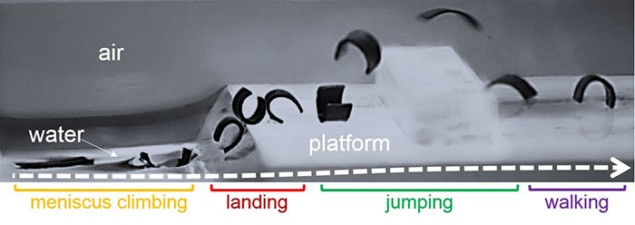
A new type of highly agile robot has been created by a team led by Metin Sitti at the Max Planck Institute for Intelligent Systems. The soft-bodied robots are controlled using applied magnetic fields and can perform a wide range of motions – allowing them to navigate through challenging terrains and environments. With the ability to carry drugs as a cargo, and even construct new tissues, the robots could have important medical applications.
Sitti and colleagues made their robots from ribbons of flexible, hydrophobic silicone rubber, embedded with microparticles of a specially designed magnetic alloy. Each ribbon is 1.5 mm wide and 185 µm thick and has a magnetization that varies sinusoidal along its 4 mm length.
When subjected to magnetic fields, the robots are bent into a wide variety of shapes. By varying the magnetic field periodically in different and creative ways, the team has shown that the robots can be controlled to move using a range of self-propulsion techniques.
Caterpillar or jellyfish
Causing the body of a robot to undulate like a time-dependent sine wave, results in motion that mimics the gait of a caterpillar – allowing the robot to roll, crawl, or walk over rough, irregular terrain. Adapting the motion further, allowed robots to jump over obstacles, and land safely. When immersed in water, the induced motion caused the robots to swim like a jellyfish, propelling itself upwards against gravity. Their hydrophobic coating also allowed the robots to crawl along the surfaces of fluids, and climb meniscuses of water.
Sitti’s team is hopeful that the dexterity of their robots will become useful to the field of medicine. Since the motion-inducing magnetic fields are harmless to humans and can penetrate through tissue, smaller versions of the robots could be used to deliver drugs by carrying them through complex and varied environments inside the body. They could also be put to construction tasks, assembling tissues, and assisting with non-invasive surgeries.
The robots are described in Nature.



